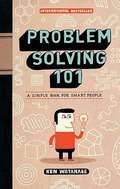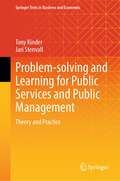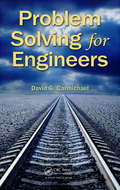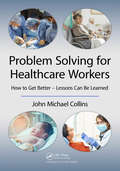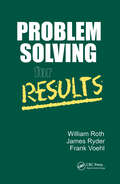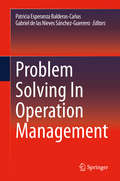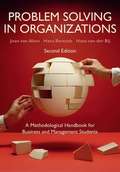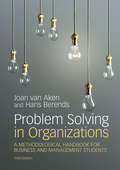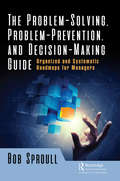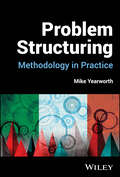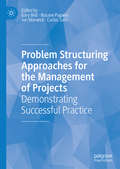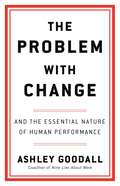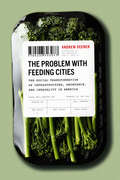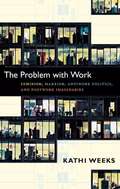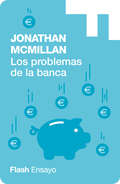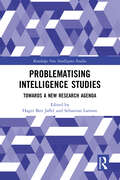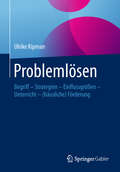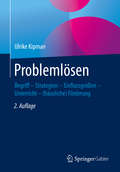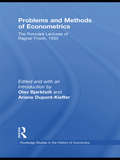- Table View
- List View
Problem Solving 101: A Simple Book for Smart People
by Ken WatanabeThe fun and simple problem-solving guide that took Japan by stormKen Watanabe originally wrote Problem Solving 101 for Japanese schoolchildren. <P><P>His goal was to help shift the focus in Japanese education from memorization to critical thinking, by adapting some of the techniques he had learned as an elite McKinsey consultant. He was amazed to discover that adults were hungry for his fun and easy guide to problem solving and decision making. The book became a surprise Japanese bestseller, with more than 370,000 in print after six months. Now American businesspeople can also use it to master some powerful skills. Watanabe uses sample scenarios to illustrate his techniques, which include logic trees and matrixes. A rock band figures out how to drive up concert attendance. An aspiring animator budgets for a new computer purchase. Students decide which high school they will attend. Illustrated with diagrams and quirky drawings, the book is simple enough for a middleschooler to understand but sophisticated enough for business leaders to apply to their most challenging problems.
Problem-solving and Learning for Public Services and Public Management: Theory and Practice (Springer Texts in Business and Economics)
by Jari Stenvall Tony KinderIn this textbook readers will acquire knowledge of problem-solving and learning to enhance both efficiency and the experience of service users in rapidly changing service environments, that can create new service models. Emphasizing that, above all else, individuals are at the centre of services, the book goes deeply into the nature of public services and their logic-of-practice. By applying learning and problem-solving approaches, the reader gains practical capabilities in addition to an appreciation of the latest research literature. Following a multidisciplinary, international approach, the book suggests a new typology of problem-framing and presents many examples of how new service solutions can be created in any public service context. The book offers a conceptual toolkit to understand and analyse dynamically changing services and the application of new technologies. Topics covered include pressing issues surrounding public services, such as e-technology, digitalisation, e-services, artificial intelligence, entrepreneurialism, sustainability, climate, inequality, developing economies, and smart cities. Chapters follow a similar structure: issue, problems, what we know, learning framework, worked example, theory and practice conclusions, as well as teacher and learner notes. Addressing advanced undergraduate and graduate students of public administration, public management, political science, sociology, computer science, and information systems, the book will also be a valuable resource for practitioners, i.e. experts and managers in public organizations, professionals in organizations working at the business and public sectors, consultants, and IT suppliers.
Problem Solving for Engineers
by David G. CarmichaelThis book takes a systematic approach to problem definition, generation of alternative solutions, analysis, and selection of the preferred solution. The book introduces fundamental terms needed to think systematically and undertake systematic problem solving and covers individual and group problem solving. It discusses the selection of the preferred solution involves decision making and fundamental concepts of decision making, including decision making in the presence of multiple criteria and uncertainty. The treatment embodies decision making for sustainability, with its blend of economics, social, and environmental considerations.
Problem Solving for Healthcare Workers: How to Get Better - Lessons Can Be Learned
by John Michael CollinsWhile most healthcare facilities have an extremely high success rate at the most challenging lifesaving work and we all know of friends and relatives who have had supreme care, mistakes are still made and patients’ lives have been put at risk and lost. How often have we heard politicians say after some disastrous report, "Lessons must be learned", but what does this really mean. Will responsible parties carry out a careful cause and effect analysis and methodically get to the root causes of the problem? Will sufficient steps be taken to permanently eradicate those causes and provide a permanent solution so that the problem will not reoccur? This is what is done in the aviation industry with the result that air travel is very safe. The low accident rate is achieved by studying the causes and using the methods of continuous improvement explained in this book. These methods are now becoming better known in the medical profession have been recommended in recent reports but are perhaps misunderstood at operational levels. This book is a basic level manual for those who have never been involved in any form of quality improvement project and is also suitable as a refresher for anyone wishing to familiarize themselves with the various techniques discussed. The aim of this book is to explain what continuous improvement is and why it’s needed; explain how individual departments can explain how and why continuous improvement is important, and helps readers recognize quality control methods in their own workplace and understand how to contribute to existing continuous improvement activities. While many of the case studies and examples are from the NHS, the author includes similar examples from around the world.
Problem Solving for New Engineers: What Every Engineering Manager Wants You to Know
by Melisa BuieThis book brings a fresh new approach to practical problem solving in engineering, covering the critical concepts and ideas that engineers must understand to solve engineering problems. Problem Solving for New Engineers: What Every Engineering Manager Wants You to Know provides strategy and tools needed for new engineers and scientists to become apprentice experimenters armed only with a problem to solve and knowledge of their subject matter. When engineers graduate, they enter the work force with only one part of what’s needed to effectively solve problems -- Problem solving requires not just subject matter expertise but an additional knowledge of strategy. With the combination of both knowledge of subject matter and knowledge of strategy, engineering problems can be attacked efficiently. This book develops strategy for minimizing, eliminating, and finally controlling unwanted variation such that all intentional variation is truly representative of the variables of interest.
Problem Solving for Results
by Victor NewmanIn this thought-provoking book Dr Newman looks beyond the conventional techniques of problem solving to the underlying process. He identifies eight stages and explains how to recognize which technique is appropriate to which stage. On this basis managers can generate solutions at both the personal and the organizational level. He shows: ¢ how to overcome the four main obstacles to developing a balanced problem solving style ¢ how to manage the relationship between problem solving style and stress ¢ how to use physical movement as an aid to problem solving. A unique feature of the book is a Problem Solving Styles Profile that enables each reader to apply the material in the text to improve their own problem solving capability. Written in a lively and practical style and drawing on examples from a wide range of real-life problems, Dr Newman’s book is certain of a warm welcome from managers, team leaders and professionals of every kind.
Problem Solving For Results
by William RothTurbulence is not new to the business world. In fact, the turbulence is increasing and managers are seeing teams spinning their wheels. But now there is a book that addresses these realities-Problem Solving for Results.Management systems are in a state of crisis and operations are more complex. The old top-down operations mode no longer suffices. Today's businesses demand speed and increased accuracy, forcing everyone to re-evaluate chains of command and tear down the walls between functions.Amid the responsibilities of traditional management lies problem solving. The push is toward moving decision-making authority down the ladder to all levels. Managers are no longer equipped to or capable of making the number and variety of necessary decisions in a vacuum. The current mode is to have employees deal directly with workplace issues and take corrective action without complaint and without management involvement.Coping with this reality and preparation for these improvements in workplace problem solving requires interest and motivation. Problem Solving for Results can facilitate this by demystifying and simplifying the process. This book bridges philosophy and theory and puts together a practical integration of all the tools necessary to get results from your investment of time, energy, and money.
Problem Solving In Operation Management
by Patricia Esperanza Balderas-Cañas Gabriel de las Nieves Sánchez-GuerreroThis volume examines problem solving and applied systems aimed at improving performance and management of organizations. The book’s eight chapters are integrated into two parts: methodologies and techniques that discuss complex dynamic analysis of the organizations, participative processes for building trend scenarios, consultancy as a systemic intervention process, processes to promote innovative goals in organizations, and analytical processes and solid mathematical representation systems. The authors also include a model to urban parks location, an analytic model to urban services location, and a system to forecast demand with fussy sets.Describes methodologies to analyze processes in complex dynamic organizations, including as participative, interventional, innovative, and analytical approaches;Clarifies a strategies for providing structure to complex organizations and applying analytical methods to decision making;Illustrates problem holistic solving strategies;Explains how to approach several problems from a holistic point of view and how analyze the subjacent processes to make decisions.
Problem Solving in Organizations
by Hans van der Bij Hans Berends Joan Van AkenThis concise introduction to the methodology of problem solving in organizations is an indispensable guide to the design and execution of practical business improvement projects in real organizational settings. The methodology is design-oriented and theory-informed. It encourages students to use the theory gained in their disciplinary courses by showing them how to do so in a fuzzy, ambiguous and politically charged, real-life organizational context. The book provides an in-depth discussion of the various aspects and steps of the process of business and organizational problem-solving. Rather than presenting the methodology as a recipe to be followed, the authors demonstrate how to adapt the approach to specific situations and to be flexible in scheduling the work at the various steps in the process. It will be indispensable to MBA and other students who venture outside the university walls to do real-life fieldwork.
Problem Solving in Organizations
by Joan Ernst van Aken Hans Berends Hans van der BijThis concise introduction to the methodology of Business Problem Solving (BPS) is an indispensable guide to the design and execution of practical projects in real organizational settings. The methodology is both result-oriented and theory-based, encouraging students to use the knowledge gained on their disciplinary courses, and showing them how to do so in a fuzzy, ambiguous and politically charged real life business context. The book provides in-depth discussion of the various steps in the process of business problem solving. Rather than presenting the methodology as a recipe to be followed, the authors demonstrate how to adapt the approach to specific situations and to be flexible in scheduling the work at various steps in the process. It will be indispensable to MBA students who are undertaking their own field work.
Problem Solving in Organizations (3rd Edition): A Methodological Handbook for Business and Management Students
by Hans Berends Joan Van AkenAn indispensable guide enabling business and management students to develop their professional competences in real organizational settings, this new and fully updated edition of Problem Solving in Organizations equips the reader with the necessary toolkit to apply the theory to practical business problems.<P> By encouraging the reader to use the theory and showing them how to do so in a fuzzy, ambiguous and politically charged, real-life organizational context, this book offers a concise introduction to design-oriented and theory-informed problem solving in organizations. In addition, it gives support for designing the overall approach to a problem-solving project as well as support for each of the steps of the problem-solving cycle: problem definition, problem analysis, solution design, interventions, and evaluation. <P>Problem Solving in Organizations is suitable for readers with a wide range of learning objectives, including undergraduates and graduates studying business and management, M.B.A students and professionals working in organizations.<P> Encourages readers to use the theory gained in their disciplinary courses by showing them how to problem solve in fuzzy, ambiguous and politically charged, real-life organizational contexts.<P>Provides an in-depth explanation of the various aspects of organizational problem-solving, showing how to adapt the approach to specific situations and how to be flexible in scheduling the work.<P>Theories are illustrated throughout with examples from real-life problem-solving projects, helping readers to understand the complexities that they will encounter in the field.
The Problem-Solving, Problem-Prevention, and Decision-Making Guide: Organized and Systematic Roadmaps for Managers
by Bob SproullEach day, managers and employees are confronted with a plethora of real problems and decisions that are creating issues suchs as lost throughput, poor quality, personnel problems, and material shortages.How they approach these daily quandaries will determine how successful they are at resolving problems and making effective decisions. It is human nature for managers to solutions before they even understand the nature of the problems they are trying to solve. As a result, they end up making blind decisions that change perfectly acceptable processes for incorrect reasons. The real secret to solving problems does not depend upon the number of sophisticated statistical tools that one applies -- The secret to solving most problems is to keep the approach simple and uncomplicated. Many managers and employees make mistakes because they fail to do what Toyota does so effortlessly -- . They fail to perform the 'genmba walk,' during which they go to see the actual process, understand the work, ask questions, and learn. By following a structured approach, and using only simple tools, most problems can be solved, effective decisions can be made, and problems prevented. The cornerstones of this book are three detailed roadmaps for solving problems, preventing problems, and making effective decisions. Each roadmap contains a step-by-step explanation on how to solve existing problems, how to prevent future problems, and how to make effective decisions. The book provides real case studies to illustrate each of the techniques presented in the book.
Problem Structuring: Methodology in Practice
by Mike YearworthCurrent perspectives on approaches to problem structuring in operational research and engineering and prospects for problem structuring methods applicable to a wide range of practice. Bridging between operational research (OR) and engineering practice, Problem Structuring: Methodology in Practice is grounded in the emergence of soft OR and its development over time as a distinctively new field, broadening the scope of OR to deal with issues of transforming, strategising, and planning in the context of wicked problems. The book is centred on a methodological framing of intervention processes known as problem structuring methods (PSMs) and the techniques presented are suitable for practitioners across a broad range of disciplines. Written by a highly qualified professor of engineering and management, Problem Structuring: Methodology in Practice contains four linked sections that cover: I. Problem formulation when dealing with wicked problems, justification for a methodological approach, the emergence of soft OR, the relevance of pragmatic philosophy to OR practice. II. Traces debates and issues in OR leading to the emergence of soft OR, comparative analysis of PSMs leading to a generic framework for soft OR practice, addressing practical considerations in delivering PSM interventions. III. Charts the emergence of a problem structuring sensibility in engineering practice, introduces a new PSM based on hierarchical process modelling (HPM) supported by teaching and case studies, makes the case for a processual turn in engineering practice supported by HPM with relevance to OR practice. IV. Evaluation of PSM interventions, survey of applications, use of group support systems, new developments supported by machine learning, recontextualising soft OR practice. Problem Structuring: Methodology in Practice is a thought-provoking and highly valuable resource relevant to all “students of problems.” It is suitable for any UK Level 7 (or equivalent) programme in OR, engineering, or applied social science where a reflective, methodological approach to dealing with wicked problems is an essential requirement for practice.
Problem Structuring Approaches for the Management of Projects: Demonstrating Successful Practice
by Gary Bell Rosane Pagano Jon Warwick Carlos SatoExploring the three levels of project management, this edited collection analyses the practice of problem structuring approaches (PSAs) with an aim to improve organisational adaptability and value creation. By studying these approaches, the authors present techniques for enhancing project management knowledge, informing decision-making and guiding management actions. This book is an insightful and timely read, as it addresses the need for organisations to adapt in order to tackle new challenges within today’s changing business landscape. Undoubtedly useful to those studying project management and operational research, this book is also an important read for managers and decision-makers within organisations as it identifies and examines the effective outcomes of PSAs.
The Problem with Change: And the Essential Nature of Human Performance
by Ashley GoodallIf you&’ve had enough of the constant turbulence that defines corporate life today, you&’re not alone. Learn why change is bad for people and for business, and discover how to create the stability that we all need to thrive. For decades, &“disruption&” and &“change&” have been seen as essential to business growth and success. In this provocative and incisive book, leadership expert Ashley Goodall argues that what has become a sacred dogma is both wrong and harmful. Whether it&’s a merger or re-org or a new office layout, change has become the ultimate easy button for leaders, who pursue it with abandon, unleashing a torrent of disruption on employees. The result is what Goodall calls &“life in the blender&”—a perpetual cycle of upheaval, uncertainty, and unease. The problem with change, Goodall argues, is that a culture where everything from people to processes to strategic priorities are constantly in flux exerts a psychological toll that undermines motivation, productivity, and performance. And yet so accustomed are we to constant churn that we have become numb to its very real consequences. Drawing on two decades spent leading HR organizations at Deloitte and Cisco, Ashley Goodall reveals why change is not the same as improvement, and how, by prioritizing team cohesion (instead of reshuffling teams at will), by using real words (rather than corporate-speak), by sharing secrets (not mission statements), by fixing only the things that are truly broken (instead of moving fast and breaking everything in sight, and more, leaders at every level can create the stability that people need to thrive.
The Problem with Feeding Cities: The Social Transformation of Infrastructure, Abundance, and Inequality in America
by Andrew DeenerFor most people, grocery shopping is a mundane activity. Few stop to think about the massive, global infrastructure that makes it possible to buy Chilean grapes in a Philadelphia supermarket in the middle of winter. Yet every piece of food represents an interlocking system of agriculture, manufacturing, shipping, logistics, retailing, and nonprofits that controls what we eat—or don’t.The Problem with Feeding Cities is a sociological and historical examination of how this remarkable network of abundance and convenience came into being over the last century. It looks at how the US food system transformed from feeding communities to feeding the entire nation, and it reveals how a process that was once about fulfilling basic needs became focused on satisfying profit margins. It is also a story of how this system fails to feed people, especially in the creation of food deserts. Andrew Deener shows that problems with food access are the result of infrastructural failings stemming from how markets and cities were developed, how distribution systems were built, and how organizations coordinate the quality and movement of food. He profiles hundreds of people connected through the food chain, from farmers, wholesalers, and supermarket executives, to global shippers, logistics experts, and cold-storage operators, to food bank employees and public health advocates. It is a book that will change the way we see our grocery store trips and will encourage us all to rethink the way we eat in this country.
The Problem with Legacy Ecosystems
by Maxwell Wessel Aaron Levie Robert Siegel"The Question Why do so many well-resourced, historically strong companies fail to keep pace with digital-native challengers? The Answer The failure stems partly from how hard it is to walk away from a successful business model. But there’s another, subtler reason: The new disrupters know more about customers, because they have access to better data. Recommendations To build effective new business models that take advantage of digital technology, older companies need to agree on the way forward, adopt new performance metrics, and rebuild their supplier, distributor, and partner networks."
The Problem with Work: Feminism, Marxism, Antiwork Politics, and Postwork Imaginaries
by Kathi WeeksIn The Problem with Work, Kathi Weeks boldly challenges the presupposition that work, or waged labor, is inherently a social and political good. While progressive political movements, including the Marxist and feminist movements, have fought for equal pay, better work conditions, and the recognition of unpaid work as a valued form of labor, even they have tended to accept work as a naturalized or inevitable activity. Weeks argues that in taking work as a given, we have "depoliticized" it, or removed it from the realm of political critique. Employment is now largely privatized, and work-based activism in the United States has atrophied. We have accepted waged work as the primary mechanism for income distribution, as an ethical obligation, and as a means of defining ourselves and others as social and political subjects. Taking up Marxist and feminist critiques, Weeks proposes a postwork society that would allow people to be productive and creative rather than relentlessly bound to the employment relation. Work, she contends, is a legitimate, even crucial, subject for political theory.
Los problemas de la banca (Flash Ensayo #Volumen)
by Jonathan McMillanUn texto que explica en qué consiste el pánico financiero, el talón de Aquiles de la banca. McMillan se centra en definir una de las amenazas que más preocupan al sistema bancario actual: el pánico financiero. El sistema bancario es enormemente frágil, ya que se basa en el crédito y en el dinero ficticio. Si hay demasiada gente que quiere retirar el dinero de sus bancos, estos entran en quiebra, dando lugar al famoso «corralito». Una sola estampida bancaria puede provocar una reacción en cadena y desembocar en un colapso total del sistema financiero, como ya se vio durante el Crac del 29 que dio paso a la Gran Depresión en Estados Unidos. McMillan explica dos formas de prevenir los pánicos bancarios: el fondo de garantía de depósitos y los Bancos Centrales, como el Sistema de la Reserva Federal en Estados Unidos, que ayudan a regularizar y poner límites a la banca. Jonathan McMillan, pseudónimo de dos autores que conocen de primera mano el funcionamiento de la banca, protagonizó un auténtico fenómeno de autopublicación. El fin de la banca, el libro desde donde se extrae este texto, identifica la raíz de los problemas actuales y presenta una solución original y realista.
Problematische Mitarbeiter erfolgreich führen
by Hartmut LauferDas Buch befasst sich mit besonderen Problemen bei der Mitarbeiterführung und zeigt, auf welchen Wegen ein partnerschaftlicher Umgang zwischen Führungskräften und Mitarbeitern gefunden werden kann.Auf der Basis aktueller psychologischer Erkenntnisse und seiner langjährigen Erfahrung als Führungskraft beleuchtet der Autor die Hintergründe problematischer Verhaltensweisen von Mitarbeitern und stellt praxiserprobte Führungstechniken und Kommunikationsinstrumente zur Bewältigung der damit einhergehenden Konflikte vor. Der Autor zeigt auf, wie Führungskräften in Mitarbeitergesprächen der schwierige Balanceakt zwischen der Wahrung der Unternehmensinteressen einerseits und der Fürsorgepflicht gegenüber Mitarbeitern andererseits gelingen kann. Daher widmet sich das abschließende Kapitel den besonderen Anforderungen, Risiken und Regeln, die bei problemspezifischen Mitarbeitergesprächen zu bedenken sind – unter anderem beim Kritikgespräch, Schlichtungsgespräch oder Trennungsgespräch. Für jede Art von Mitarbeitergespräch bietet der Band Checklisten und Leitfäden zur Anwendung im Führungsalltag.
Problematising Intelligence Studies: Towards A New Research Agenda (Routledge New Intelligence Studies)
by Hager Ben JaffelThis book offers a new research agenda for intelligence studies in contemporary times. In contrast to Intelligence Studies (IS), whose aim has largely been to improve the performance of national security services and assist in policy making, this book takes the investigation of the new professionals and everyday practices of intelligence as the immediate point of departure. Starting from the observation that intelligence today is increasingly about counter-terrorism, crime control, surveillance, and other security-related issues, this book adopts a transdisciplinary approach for studying the shifting logics of intelligence, how it has come to involve an expanding number of empirical sites, such as the police, local community, prison and the Internet, as well as a corresponding multiplicity of new actors in these domains. Shifting the focus away from traditional spies and Anglo-American intelligence services, this book addresses the transformations of contemporary intelligence through empirically detailed and theoretically innovative analyses, making a key contribution to existing scholarship. This book will be of much interest to students of intelligence studies, critical security studies, foreign policy, and International Relations.
Problemlösen: Begriff – Strategien – Einflussgrößen – Unterricht – (häusliche) Förderung
by Ulrike KipmanProblemlösen gilt als eine der Schlüsselqualifikationen des 21. Jahrhunderts. Es geht beim Problemlösen nicht nur darum, Informationen sinnvoll zu vernetzen, dynamisch in Beziehung zu setzen, Wahrscheinlichkeiten zu berechnen und eine Kette richtiger Entscheidungen zu treffen, sondern auch vielfach darum, eine Vielzahl an Außenkriterien zu berücksichtigen und ein entsprechendes „Weltwissen“ an den Tag zu legen. Dieses Buch soll die Frage beantworten, wie man zu einem guten Problemlöser / einer guten Problemlöserin werden kann bzw. warum bestimmte Personen bei der Lösung von Problemen erfolgreicher sind als andere. Nach einer umfassenden Zusammenstellung der Literatur zu diesem Thema werden Einflussgrößen auf das Problemlösen analysiert und miteinander abgeglichen und Ideen für den Unterricht in der Primarstufe und Sekundarstufe I präsentiert. Zudem werden verschiedene Arten des Unterrichts im Hinblick auf die Wirksamkeit für unterschiedliche Personengruppen diskutiert, dies vor dem Hintergrund, dass nicht nur Problemstellungen stark variieren sondern auch die Problemlöser/innen. Eine Handreichung mit Brettspielen, die die Kriterien des Problemlösens erfüllen, ist ebenfalls Teil dieses Buches. Letztendlich wird ein Modell vorgeschlagen, welches erfolgreiches Problemlösen vielschichtig zu erklären versucht.
Problemlösen: Begriff – Strategien – Einflussgrößen – Unterricht – (häusliche) Förderung
by Ulrike KipmanProblemlösen gilt als eine der Schlüsselqualifikationen des 21. Jahrhunderts. Es geht beim Problemlösen nicht nur darum, Informationen sinnvoll zu vernetzen, dynamisch in Beziehung zu setzen, Wahrscheinlichkeiten zu berechnen und eine Kette richtiger Entscheidungen zu treffen, sondern auch vielfach darum, eine Vielzahl an Außenkriterien zu berücksichtigen und ein entsprechendes „Weltwissen“ an den Tag zu legen. Dieses Buch soll die Frage beantworten, wie man zu einem guten Problemlöser / einer guten Problemlöserin werden kann bzw. warum bestimmte Personen bei der Lösung von Problemen erfolgreicher sind als andere. Nach einer umfassenden Zusammenstellung der Literatur zu diesem Thema werden Einflussgrößen auf das Problemlösen analysiert und miteinander abgeglichen und Ideen für den Unterricht in der Primarstufe und Sekundarstufe I präsentiert. Zudem werden verschiedene Arten des Unterrichts im Hinblick auf die Wirksamkeit für unterschiedliche Personengruppen diskutiert, dies vor dem Hintergrund, dass nicht nur Problemstellungen stark variieren sondern auch die Problemlöser/innen. Eine Handreichung mit Brettspielen, die die Kriterien des Problemlösens erfüllen, ist ebenfalls Teil dieses Buches. Letztendlich wird ein Modell vorgeschlagen, welches erfolgreiches Problemlösen vielschichtig zu erklären versucht. In der 2. Auflage wurden alle Kapitel überarbeitet und an den neuesten Kenntnisstand zum Thema Problemlösen angepasst. Die Kapitel zur schulischen und häuslichen Förderung der Problemlösekompetenz wurden stark erweitert und es werden nun eine Vielzahl an neuen Aufgaben und Spielen präsentiert, die beim Fördern von Problemlösen eine wertvolle Unterstützung leisten können. Das Kapitel zur Kombinatorik wurde nach der Rückmeldung von Studierenden und Kollegen komplett umstrukturiert und ist nun verständlicher und übersichtlicher aufgebaut.
Problems and Materials on Commercial Law (Aspen Casebook Series)
by Douglas J. Whaley Stephen M. McJohnClear, lucid, and extremely accessible, Problems and Materials on Commercial Law helps students understand black letter law and the statutory language in the Uniform Commercial Code. Concise yet comprehensive coverage includes the most recent case and statutory developments in all fundamental areas of Commercial Law, including sales, payment systems, and secured transactions. A sensible, flexible organization follows the order of UCC Articles 2, 3, 4, and 9, and is adaptable to many teaching styles. Drawing on experience in both teaching and writing, the authors provide thorough and practical coverage using a popular problem approach. <p><p>The text s effective format, manageable length, and inclusion of the most important cases make Problems and Materials on Commercial Law concise and efficient. A Teacher s Manual provides sample syllabi, answers to all the problems in the text, and suggestions on the best ways to teach various topics.
Problems and Methods of Econometrics: The Poincaré Lectures of Ragnar Frisch 1933 (Routledge Studies in the History of Economics)
by Ragnar FrischThe development of economics changed dramatically during the twentieth century with the emergence of econometrics, macroeconomics and a more scientific approach in general. One of the key individuals in the transformation of economics was Ragnar Frisch, professor at the University of Oslo and the first Nobel Laureate in economics in 1969. He was a co-founder of the Econometric Society in 1930 (after having coined the word econometrics in 1926) and edited the journal Econometrics for twenty-two years. The discovery of the manuscripts of a series of eight lectures given by Frisch at the Henri Poincaré Institute in March–April 1933 on The Problems and Methods of Econometrics will enable economists to more fully understand his overall vision of econometrics. This book is a rare exhibition of Frisch’s overview on econometrics and is published here in English for the first time. Edited and with an introduction by Olav Bjerkholt and Ariane Dupont-Kieffer, Frisch’s eight lectures provide an accessible and astute discussion of econometric issues from philosophical foundations to practical procedures. Concerning the development of economics in the twentieth century and the broader visions about economic science in general and econometrics in particular held by Ragnar Frisch, this book will appeal to anyone with an interest in the history of economics and econometrics.
